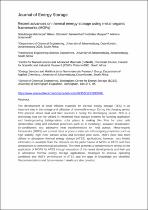JavaScript is disabled for your browser. Some features of this site may not work without it.
- ResearchSpace
- →
- Research Publications/Outputs
- →
- Journal Articles
- →
- View Item
| dc.contributor.author |
Makhanya, N

|
|
| dc.contributor.author |
Oboirien, B

|
|
| dc.contributor.author |
Ren, J

|
|
| dc.contributor.author |
Musyoka, Nicholas M

|
|
| dc.contributor.author |
Sciacovelli, A

|
|
| dc.date.accessioned | 2021-04-10T11:07:37Z | |
| dc.date.available | 2021-04-10T11:07:37Z | |
| dc.date.issued | 2021-02 | |
| dc.identifier.citation | Makhanya, N., Oboirien, B., Ren, J., Musyoka, N.M. & Sciacovelli, A. 2021. Recent advances on thermal energy storage using metal-organic frameworks (MOFs). <i>Journal of Energy Storage, 34.</i> http://hdl.handle.net/10204/11967 | en_ZA |
| dc.identifier.issn | 2352-152X | |
| dc.identifier.uri | https://doi.org/10.1016/j.est.2020.102179 | |
| dc.identifier.uri | https://www.sciencedirect.com/science/article/pii/S2352152X20320041 | |
| dc.identifier.uri | http://hdl.handle.net/10204/11967 | |
| dc.description.abstract | The development of novel efficient materials for thermal energy storage (TES) is an important step in the storage and utilisation of renewable energy. During the charging period, TES process stores heat and later releases it during the discharging period. TES is a technology that can be utilized in residential heat storage systems for building application and heating/cooling (refrigeration), solar plants in making thin films for solar cells (photovoltaic cells) and industrial processes such as in metallurgy, seawater desalination, air-conditioners and adsorptive heat transformations for heat pumps. Metal-organic frameworks (MOFs) are a novel class of porous materials with intriguing properties such as high stability, high inner surface areas and tuneable pore sizes. MOFs have also been utilized in adsorption thermal energy storage (ATES) applications; however, very limited information is available from the literature on the performance of MOFs in ATES and their comparisons to conventional adsorbents. This work presents a comprehensive review on the application of MOFS for ATES through evaluation of the recent developments and their use in adsorption thermal energy storage applications. Strategies to improve operating conditions and MOFs performance in ATES and the gaps in knowledge are identified. Recommendations and future research needs are also provided. | en_US |
| dc.format | Abstract | en_US |
| dc.language.iso | en | en_US |
| dc.source | Journal of Energy Storage, 34 | en_US |
| dc.subject | Metal-Organic Frameworks | en_US |
| dc.subject | MOFs | en_US |
| dc.subject | Thermal energy storage | en_US |
| dc.title | Recent advances on thermal energy storage using metal-organic frameworks (MOFs) | en_US |
| dc.type | Article | en_US |
| dc.description.pages | 18pp | en_US |
| dc.description.note | © 2020 Elsevier Ltd. All rights reserved. Due to copyright restrictions, the attached PDF file only contains the abstract of the full text item. For access to the full text item, please consult the publisher's website: https://www.sciencedirect.com/science/article/pii/S2352152X20320041 | en_US |
| dc.description.cluster | Chemicals | en_US |
| dc.description.impactarea | Hydrogen SA | en_US |
| dc.identifier.apacitation | Makhanya, N., Oboirien, B., Ren, J., Musyoka, N. M., & Sciacovelli, A. (2021). Recent advances on thermal energy storage using metal-organic frameworks (MOFs). <i>Journal of Energy Storage, 34</i>, http://hdl.handle.net/10204/11967 | en_ZA |
| dc.identifier.chicagocitation | Makhanya, N, B Oboirien, J Ren, Nicholas M Musyoka, and A Sciacovelli "Recent advances on thermal energy storage using metal-organic frameworks (MOFs)." <i>Journal of Energy Storage, 34</i> (2021) http://hdl.handle.net/10204/11967 | en_ZA |
| dc.identifier.vancouvercitation | Makhanya N, Oboirien B, Ren J, Musyoka NM, Sciacovelli A. Recent advances on thermal energy storage using metal-organic frameworks (MOFs). Journal of Energy Storage, 34. 2021; http://hdl.handle.net/10204/11967. | en_ZA |
| dc.identifier.ris | TY - Article AU - Makhanya, N AU - Oboirien, B AU - Ren, J AU - Musyoka, Nicholas M AU - Sciacovelli, A AB - The development of novel efficient materials for thermal energy storage (TES) is an important step in the storage and utilisation of renewable energy. During the charging period, TES process stores heat and later releases it during the discharging period. TES is a technology that can be utilized in residential heat storage systems for building application and heating/cooling (refrigeration), solar plants in making thin films for solar cells (photovoltaic cells) and industrial processes such as in metallurgy, seawater desalination, air-conditioners and adsorptive heat transformations for heat pumps. Metal-organic frameworks (MOFs) are a novel class of porous materials with intriguing properties such as high stability, high inner surface areas and tuneable pore sizes. MOFs have also been utilized in adsorption thermal energy storage (ATES) applications; however, very limited information is available from the literature on the performance of MOFs in ATES and their comparisons to conventional adsorbents. This work presents a comprehensive review on the application of MOFS for ATES through evaluation of the recent developments and their use in adsorption thermal energy storage applications. Strategies to improve operating conditions and MOFs performance in ATES and the gaps in knowledge are identified. Recommendations and future research needs are also provided. DA - 2021-02 DB - ResearchSpace DP - CSIR J1 - Journal of Energy Storage, 34 KW - Metal-Organic Frameworks KW - MOFs KW - Thermal energy storage LK - https://researchspace.csir.co.za PY - 2021 SM - 2352-152X T1 - Recent advances on thermal energy storage using metal-organic frameworks (MOFs) TI - Recent advances on thermal energy storage using metal-organic frameworks (MOFs) UR - http://hdl.handle.net/10204/11967 ER - | en_ZA |
| dc.identifier.worklist | 24277 | en_US |






